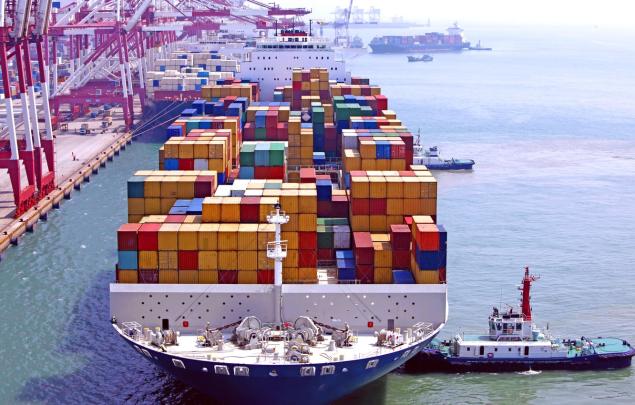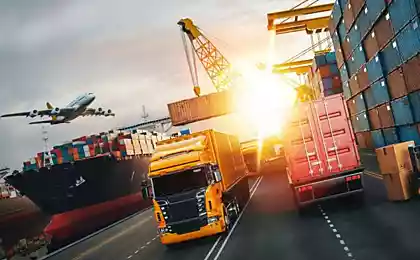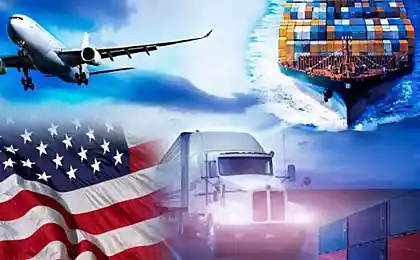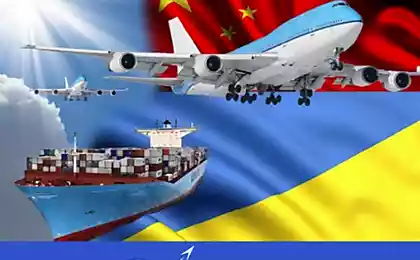398
International shipping of goods: 7 amazing facts
International shipping of goods: 7 amazing facts
The world economy depends on the international transport of goods from producers and suppliers in one country to consumers in another. Despite the shortage of containers and the COVID-19 pandemic, shipping plays a crucial role in door-to-door delivery.
Here are seven amazing shipping facts to help you better appreciate the role and importance of international freight exports.

You may need to complete an export declaration.
Depending on local laws and regulations, a shipping company or international freight forwarder may be required to complete and submit an export declaration to its local customs authority. As part of the customs clearance process, an export declaration must be sent before shipment of goods from the country of origin to the country of destination.
An export declaration is a form similar to a commercial invoice. It contains information about the product, in particular about its type, quantity and estimated market value of the goods (for example, delivery from China for marketplaces).
Customs use export declarations to estimate the value of goods for customs duties and to collect data on international trade and shipping. Customs agents use data mainly for statistical purposes.
Hong Kong airport is the busiest in the world
Although it is not the largest airport in East Asia in terms of size, Hong Kong International Airport (HKIA) is the busiest in the world for freight traffic. In 2020 alone, more than 4.5 million tons of cargo passed through this airport.
According to data collected by the Hong Kong government, more than 120 companies provide logistics services linking cargo to and from the OAS. These logistics firms link HKIA to 220 other destinations around the world, often offering competitive airfares.
One of the reasons for this is the advantageous location of Hong Kong. Aircraft from Hong Kong can reach half of the world’s population in about five hours, making it an important port of departure for international transport and logistics services, whether port of origin or destination.
Despite this convenience, freight volume fell by 7% in 2020 due to disruptions in the COVID-19 supply chain, leading to a sharp increase in transportation costs.
However, as of 2023, demand for air cargo and cargo turnover in Hong Kong is gradually recovering. The gradual relaxation of lockdowns and the resumption of production capacity in China are improving the working conditions of firms operating in Hong Kong.
Piracy at sea remains a problem.
In the twenty-first century, you might be surprised to learn that maritime piracy is still a major global shipping problem. Piracy is a serious threat to the security of maritime logistics companies in many parts of the world. According to the International Chamber of Commerce (ICC), the Gulf of Guinea accounted for 43% of all piracy-related incidents in the first quarter of 2021.
Other hotbeds of piracy near international shipping lanes include the South China Sea, the Gulf of Aden, the coasts of Benin, Somalia and Nigeria, and the Strait of Malacca.
The threat of piracy in particular has led to higher maritime insurance rates, as modern pirates typically demand ransom in exchange for the safe release of cargo and crew.
In 2020, there were 68 separate incidents of piracy, including kidnappings of crew members. Container shipping companies tend to take ocean safety seriously in response to this threat by adopting a range of safety measures to protect against pirates. For example, an international transport company may hire patrol vessels, hire armed guards, or use ship-based protective devices.
Most goods are transported by sea.
Although demand for air transport remains high, maritime shipping is still the main mode of international cargo transportation. The main reason is throughput; although sea freight is the slowest of the three main modes of transport (land, sea, air), cargo ships can carry much larger volumes of cargo than trains, planes or trucks.
Thus, more than 90% of the world’s cargo is transported by sea. The shipping industry, in particular the maritime freight sector, plays a vital role in ensuring that the global economy continues to develop.
At the same time, most passenger aircraft also carry cargo, which accounts for 5-10% of the airline’s revenue. The United States Postal Service rents cargo space on most commercial flights.
More than 1.5 million seafarers work in the shipping industry
According to the International Chamber of Shipping (IPU), a global trade association, more than 1.5 million seafarers (about 790,000 officers and 754,000 ratings) have more than 50,000 merchant ships supporting international trade.
Seven of the world’s largest shipping lines (Mediterranean Shipping Company, Maersk Line, CMA CGM, COSCO, Hapag-Lloyd, Evergreen and ONE) own or operate more than 3,100 ships, and their container traffic is more than 19.7 million TEU.
The main suppliers of qualified seafarers are China, Indonesia, Russia, Ukraine and the Philippines. However, while maritime trade continues to grow, there is a shortage of skilled seafarers.
Container ships consume large amounts of fuel
Some may be surprised at how much fuel a container ship consumes in international shipping.
The amount of fuel a container ship requires depends on its engine power, the size of the fuel tank and the trade route chosen. For these reasons, fuel costs are among the biggest expenses of logistics companies, container shipping firms and freight forwarders.
Although the average fuel consumption of a cargo line varies depending on its size, container ship and speed, a typical vessel with a carrying capacity of 7,000-8000 TEU moving at 21 knots per hour would require approximately 125 tons of bunker fuel per day, or about 29,700 gallons.
For example, traveling the delivery route from Los Angeles to Tokyo (20,321 nautical miles) at this speed takes just over 40 days and consumes about 5,040 tons of fuel, or just under 1.2 million gallons of fuel.
The increase in fuel consumption is due to two factors: an increase in the speed of ships and an increase in the weight of cargo. For example, a Panamax container ship (load capacity: 5,000 TEU) can consume up to 63,000 gallons of fuel per day at a top speed (20 to 25 knots per hour).

Ships are rarely inspected.
For example, in the United States, the Customs and Border Protection Agency (CBP) is responsible for managing international trade, regulating the import and export of goods, and collecting import duties. CBP also inspects certain types of imports.
It may be surprising, however, that the agency only inspects a relatively small proportion of cargo ships calling at U.S. ports.
Due to the huge volume of shipments to the U.S. (over $2.5 trillion), CBP cannot verify them all. Instead, the agency uses an automated targeting system (ATS) to calculate risk across multiple variables.
Although CBP does not disclose the exact factors and details, ATN takes into account the following:
The world economy depends on the international transport of goods from producers and suppliers in one country to consumers in another. Despite the shortage of containers and the COVID-19 pandemic, shipping plays a crucial role in door-to-door delivery.
Here are seven amazing shipping facts to help you better appreciate the role and importance of international freight exports.

You may need to complete an export declaration.
Depending on local laws and regulations, a shipping company or international freight forwarder may be required to complete and submit an export declaration to its local customs authority. As part of the customs clearance process, an export declaration must be sent before shipment of goods from the country of origin to the country of destination.
An export declaration is a form similar to a commercial invoice. It contains information about the product, in particular about its type, quantity and estimated market value of the goods (for example, delivery from China for marketplaces).
Customs use export declarations to estimate the value of goods for customs duties and to collect data on international trade and shipping. Customs agents use data mainly for statistical purposes.
Hong Kong airport is the busiest in the world
Although it is not the largest airport in East Asia in terms of size, Hong Kong International Airport (HKIA) is the busiest in the world for freight traffic. In 2020 alone, more than 4.5 million tons of cargo passed through this airport.
According to data collected by the Hong Kong government, more than 120 companies provide logistics services linking cargo to and from the OAS. These logistics firms link HKIA to 220 other destinations around the world, often offering competitive airfares.
One of the reasons for this is the advantageous location of Hong Kong. Aircraft from Hong Kong can reach half of the world’s population in about five hours, making it an important port of departure for international transport and logistics services, whether port of origin or destination.
Despite this convenience, freight volume fell by 7% in 2020 due to disruptions in the COVID-19 supply chain, leading to a sharp increase in transportation costs.
However, as of 2023, demand for air cargo and cargo turnover in Hong Kong is gradually recovering. The gradual relaxation of lockdowns and the resumption of production capacity in China are improving the working conditions of firms operating in Hong Kong.
Piracy at sea remains a problem.
In the twenty-first century, you might be surprised to learn that maritime piracy is still a major global shipping problem. Piracy is a serious threat to the security of maritime logistics companies in many parts of the world. According to the International Chamber of Commerce (ICC), the Gulf of Guinea accounted for 43% of all piracy-related incidents in the first quarter of 2021.
Other hotbeds of piracy near international shipping lanes include the South China Sea, the Gulf of Aden, the coasts of Benin, Somalia and Nigeria, and the Strait of Malacca.
The threat of piracy in particular has led to higher maritime insurance rates, as modern pirates typically demand ransom in exchange for the safe release of cargo and crew.
In 2020, there were 68 separate incidents of piracy, including kidnappings of crew members. Container shipping companies tend to take ocean safety seriously in response to this threat by adopting a range of safety measures to protect against pirates. For example, an international transport company may hire patrol vessels, hire armed guards, or use ship-based protective devices.
Most goods are transported by sea.
Although demand for air transport remains high, maritime shipping is still the main mode of international cargo transportation. The main reason is throughput; although sea freight is the slowest of the three main modes of transport (land, sea, air), cargo ships can carry much larger volumes of cargo than trains, planes or trucks.
Thus, more than 90% of the world’s cargo is transported by sea. The shipping industry, in particular the maritime freight sector, plays a vital role in ensuring that the global economy continues to develop.
At the same time, most passenger aircraft also carry cargo, which accounts for 5-10% of the airline’s revenue. The United States Postal Service rents cargo space on most commercial flights.
More than 1.5 million seafarers work in the shipping industry
According to the International Chamber of Shipping (IPU), a global trade association, more than 1.5 million seafarers (about 790,000 officers and 754,000 ratings) have more than 50,000 merchant ships supporting international trade.
Seven of the world’s largest shipping lines (Mediterranean Shipping Company, Maersk Line, CMA CGM, COSCO, Hapag-Lloyd, Evergreen and ONE) own or operate more than 3,100 ships, and their container traffic is more than 19.7 million TEU.
The main suppliers of qualified seafarers are China, Indonesia, Russia, Ukraine and the Philippines. However, while maritime trade continues to grow, there is a shortage of skilled seafarers.
Container ships consume large amounts of fuel
Some may be surprised at how much fuel a container ship consumes in international shipping.
The amount of fuel a container ship requires depends on its engine power, the size of the fuel tank and the trade route chosen. For these reasons, fuel costs are among the biggest expenses of logistics companies, container shipping firms and freight forwarders.
Although the average fuel consumption of a cargo line varies depending on its size, container ship and speed, a typical vessel with a carrying capacity of 7,000-8000 TEU moving at 21 knots per hour would require approximately 125 tons of bunker fuel per day, or about 29,700 gallons.
For example, traveling the delivery route from Los Angeles to Tokyo (20,321 nautical miles) at this speed takes just over 40 days and consumes about 5,040 tons of fuel, or just under 1.2 million gallons of fuel.
The increase in fuel consumption is due to two factors: an increase in the speed of ships and an increase in the weight of cargo. For example, a Panamax container ship (load capacity: 5,000 TEU) can consume up to 63,000 gallons of fuel per day at a top speed (20 to 25 knots per hour).

Ships are rarely inspected.
For example, in the United States, the Customs and Border Protection Agency (CBP) is responsible for managing international trade, regulating the import and export of goods, and collecting import duties. CBP also inspects certain types of imports.
It may be surprising, however, that the agency only inspects a relatively small proportion of cargo ships calling at U.S. ports.
Due to the huge volume of shipments to the U.S. (over $2.5 trillion), CBP cannot verify them all. Instead, the agency uses an automated targeting system (ATS) to calculate risk across multiple variables.
Although CBP does not disclose the exact factors and details, ATN takes into account the following:
- Whether the goods are import or export shipments
- For example, hazardous materials are more likely to be inspected than less dangerous goods.
- Country of origin
- Port of destination
- Identification of logistics service provider or supplier
- Whether the supplier is a first-time importer or a recidivist (in such cases, more thorough inspections are usually carried out)
Careless gardeners make the same mistakes that prevent peonies from blooming
All my life I lived with my mother, while my sister arranged her life, and now it has turned against me.























